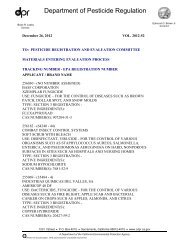Dichlorvos (DDVP) Risk Characterization Document - California ...
Dichlorvos (DDVP) Risk Characterization Document - California ...
Dichlorvos (DDVP) Risk Characterization Document - California ...
You also want an ePaper? Increase the reach of your titles
YUMPU automatically turns print PDFs into web optimized ePapers that Google loves.
C. SUBCHRONIC TOXICITY<br />
Summary: Subchronic exposures to <strong>DDVP</strong> resulted in the inhibition of brain, erythrocyte, or/and<br />
plasma ChE activities in humans, rats, mice, dogs, and cows. Clinical signs observed in laboratory<br />
animals were tremors, diarrhea, decreased body weight gain, increased frequency of salivation and<br />
urine staining in rats, and increased activity and urination in dogs. Other effects included decreases in<br />
red blood cell parameters (cell counts, hemoglobin, and hematocrit) in rats. From studies with<br />
lactating rats and milk cows after oral subchronic dosing, ChE activity depression and cholinergic<br />
signs were noted in the dams, but not in the offspring. Only studies with adequate descriptions of<br />
procedures and results were used for the determination of a critical NOEL, and they are presented in<br />
Table 3.<br />
Gavage - Rat<br />
Sprague-Dawley rats (Crl:CD.BR, 15/sex/group) were given <strong>DDVP</strong> (97.87% purity; 0. 0.1, 7.5, or 15<br />
mg/kg-day) by gavage 7 days per week for 13 weeks (Lamb, 1993b). Tremors, salivation,<br />
exophthalmus, lacrimation, clear material on forelimbs, rales, chromodacryorrhea and material around<br />
the mouth were observed in the 15 mg/kg-day group with most of the clinical signs observed shortly<br />
after dosing (about 15 minutes). Tremors, salivation, and exophthalmus were observed in the 7.5<br />
mg/kg-day group starting at week 3. Body weights of the 15 mg/kg-day females were significantly<br />
lower (91% of control value) by week 13. Plasma ChE activity of the 7.5 and 15 mg/kg-day groups<br />
was significantly (p @ 0.05) inhibited at weeks 3, 7, and 13, and the activity ranged from 42% to 66%<br />
of control values. Erythrocyte ChE activity was not significantly inhibited, except for the 35% decrease<br />
(65% of control) in the 15 mg/kg-day group after 3 weeks of treatment. At week 13, brain stem and/or<br />
cerebral cortex ChE activity ranged from 88-89% of control values in the 7.5 mg/kg-day group, and<br />
84-90% of control values in the 15 mg/kg-day groups. No adverse effects were observed in the<br />
functional observational battery, locomotor, brain weight, brain dimension or neuropathological<br />
parameters. The NOEL was determined to be 0.1 mg/kg-day based on cholinergic signs and<br />
cholinesterase inhibition.<br />
Sprague-Dawley rats (Crl:CD (SD) BR, 10/sex/group) were given <strong>DDVP</strong> (98.3% purity; 0, 0.1, 1.5, or<br />
15 mg/kg-day) by gavage 5 days per week for 13 weeks (Kleeman, 1988). The adjusted dosages<br />
were 0, 0.1, 1.1, or 10.7 mg/kg-day adjusted for 5 days/week dosing. Frequent salivation and urine<br />
staining on the fur were observed in the highest dose of 15 mg/kg-day after 6-12 weeks for males and<br />
8-12 weeks for females. The NOEL for cholinergic signs was 1.5 mg/kg-day (adjusted 1.1 mg/kgday).<br />
At week 14, erythrocyte ChE activity was significantly (p @ 0.05) reduced to 75% of the control<br />
value in the 1.5 mg/kg-day treated males and to 92% of the control value in the 0.1 mg/kg-day treated<br />
females. The NOELs for erythrocyte ChE enzyme inhibition were determined to be 0.1 mg/kg-day in<br />
males, and < 0.1 mg/kg-day in females. The plasma ChE activity was significantly (p @ 0.05) reduced<br />
to 65 and 53% of control values for the males and females, respectively, in the 15 mg/kg-day group.<br />
There was a significant (p @ 0.05) decrease (nearly 50%) in brain ChE activity in the 15 mg/kg<br />
females, and a reduction of lesser magnitude was noted in the males. The NOEL for brain ChE<br />
inhibition was 1.5 mg/kg-day (adjusted 1.1 mg/kg-day). In addition at week 14, significant (p @ 0.05)<br />
and dose-related decreases in the red blood cell parameters (cell count, hemoglobin, and hematocrit)<br />
were noted in both sexes at 15 mg/kg-day, as well as in the males at 1.5 mg/kg-day. For rats treated<br />
with 15 mg/kg-day, the decreases for cell count, hemoglobin, and hematocrit were 9-13%, 9-15%, and<br />
7-10%, respectively, of control values. The decrease in hemoglobin and hematocrit were 10 and 8%,<br />
respectively, for the male rats at 1.5 mg/kg-day.<br />
F344N rats (10/sex/group) were given <strong>DDVP</strong> (99% purity; 0, 2, 4, 8, or 16 mg/kg-day equivalent to 0,<br />
1.4, 2.9, 5.7, or 11.4 mg/kg-day adjusted for 5 days/week dosing) for 1 month, and ChE activities were<br />
measured after 10, 24, and 32 days of treatment (Chan, 1989). No clinical signs were reported.<br />
Plasma ChE activities of all treatment groups in both sexes were significantly (p @ 0.05) reduced in a<br />
25
















